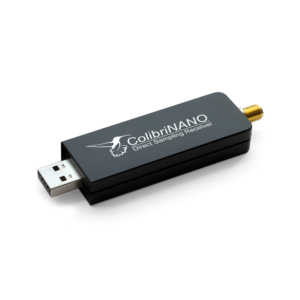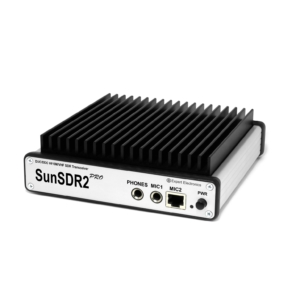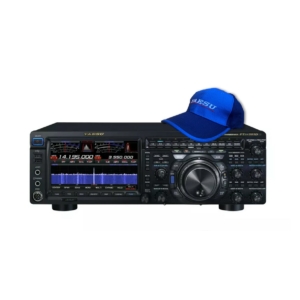SDR radio became popular in Hungary around 2012-2013 thanks to the RTL chip versions appearing among DVB-T Chinese USB TV receivers. Back then it was hard to get these products in Europe, you had to order them from China. Since then the situation has changed a lot here, too.
What can SDR radios be used for?
As the name suggests, we’re talking about software defined radio, i.e. a computer programme converts the radio signals received. Thus the modulation of the different radio modes is only a question of software: AM, FM, USB, SSB, LSB, DAB and other analogue and digital modes.

- Receiving amateur radio broadcasts
SDR devices made it easy to receive SSB and CW broadcasts on VHF band between 144 and 145. Until now CW, SSB and USB reception were only the privilege of more pricey radios.
- NOAA satellite reception
Fax image broadcasts from weather satellites are easy to record with the SDR programme and can be processed immediately, and you can see the up-to-date weather forecast straight away. Clouds, infra images and lots of other useful data for novice meteorologists.
- Spectrum monitoring
At the maximum bandwidth of 3.2MHz, radio traffic within the reception range of the SDR becomes visible. You don’t just hear, you see things, too.
- Amateur radio satellite monitoring
You could even receive the USB broadcast of MaSat-1 on UHF by using the dedicated software to record data packages.
- Listening to Satcom satellite 255MHz
These devices made it possible to monitor not only amateur satellites, but also lots of other satellite broadcasts. The various accessories used to convert high frequencies to lower ones made the range of 5-10-20GHz available, too.
- Monitoring air traffic
Processing the transponder ADSB signals of aircraft above 1GHz / using e4000 and t820 tuners. Thanks to SDR radios, you can now track aircraft not only on your PC, but also on your Android mobile using little icons displayed on Google maps.
- Manufacturing affordable lab instruments
Since the signal received is displayed visually in the SDR software, it is ideally suited to monitoring the modulation signal shape of a radio broadcast (signal level, distorted broadcast and all other parameters). Moreover, an accurately calibrated SDR receiver can be used as a frequency meter and even as a Scoop.

What makes SDR devices so significant?
The capabilities and functions inside SDR radios have, until now, been available only in high-priced communication receivers and amateur radios. These devices had a limited range of users due to their price tag at the very least. Radio enthusiasts and amateurs on a low budget, or perhaps young people interested in technology were not always able to afford such expensive, highly spec’ed devices. That is what led to the spreading of DVB-T tuners that you can get for a few dollars; the types equipped with an RTL2832U controller chip were the ones that became suitable for the purposes of radio.
Difficult beginnings
It was the Linux driver that provided the loophole for unlocking the tuner chip. Urban legend has it that the DVB-T tuner wasn’t working under Linux, and it was while writing the driver that a loophole was discovered, namely that it isn’t only the TV viewing programme that can use the tuner chip! The tuner chip is the second key component of the SDR receiver. It also mattered which version was in the DVB-T device. It was no use having an RTL controller if the SDR software couldn’t handle your tuner chip. Many people fell into the trap of trying to make use of TV receivers sold in Hungarian stores under the name of DVB-T tuner, an attempt doomed to failure in 99% of cases. At the time there were no DVB-T receivers equipped with this kind of tuner chip commercially available in Hungary.
The Windows program icon was launched, too
Since the use of Linux required a certain degree of skill and was only convenient for a narrow customer niche, Windows-based SDR programmes were needed to pave the way for the spread of RTLSDR tuners. It was with the HDSDR programme that an RTLSDR tuner was launched after some lengthy digging about on foreign websites and forums. It was a tough installation as the original TV tuner drivers had to be over-written by a dedicated driver. After loads of copying from here to there, numerous reboots, editing INI files and other tricky solutions, the programme just started up and was able to detect the tuner. The thrill was like that caused by finding water in the desert!
The advent of SDRsharp and the Zadig driver installer
Then came the Zadig programme that made it all so much easier by eliminating the confusing nightmare of installation. It was now enough to launch Zadig and select the RTL chip set from the USB devices. The programme would install the appropriate driver and if everything went well, your SDR programme would recognise the tuner on rebooting.
Among SDR programmes it was SDRsharp that delivered ease of use. It already had a logical user interface, was easy to use and had a host of Plugins at its disposal to make the most of all those functionalities without trouble. After an easy reboot you could take pleasure in the spectrum monitor and the wall of water while listening to the enchanting static noise on your speakers.
Apps also working under Android: SDRtouch driver and SDRtouch
Since around 2013 Android mobiles already had the OTG function, it became possible to run RTL SDR devices under Android, too. Martin Marinov was the first person to make a free driver for RTLSDR’s on Android, as well as an app called SDRtouch. The app had more basic functionalities, yet it was a huge deal back then that you had a radio receiver running on your mobile that was capable of covering a range of up to 2GHz! As of early October 2019 the app is on version 2.69 and can handle a large number of tuner types. It has nearly all the important features you may need and you can control via your mobile. Last but not least, this app is the only one as of now capable of handling the SDRplay tool, as well. Your smartphone has all of a sudden been turned into a scanner and a world receiver.

Chinese manufacturers were also busy at enhancing their alternative RTLSDR versions, eliminating the bugs spotted over the years. Such a bug was the crystal oscillator that provided a system frequency of 27MHz. The problem here was that over an extended period of use the base frequency would drift, causing the currently received frequency to drift, sometimes in a big way. To prevent this, they started to replace the oscillators with TXCO’s in the re-designed versions.
The advantage of TXCO is that a change in the temperature does not affect its frequency, which remains stable even with extended use.
Brand manufacturers have also entered the SDR market
Over the years major manufacturers have noticed the opportunities offered by SDR and have launched devices containing those features you had to buy extra with small Chinese tuners. In Europe the most popular manufacturers are SDRPlay and Expert Electronics, but recently Yaesu has included the SDR function in its new FTDX-101D walkie-talkie.
Looking back over the past few years, this technology has gone through an enormous development, and the story is not over yet!











